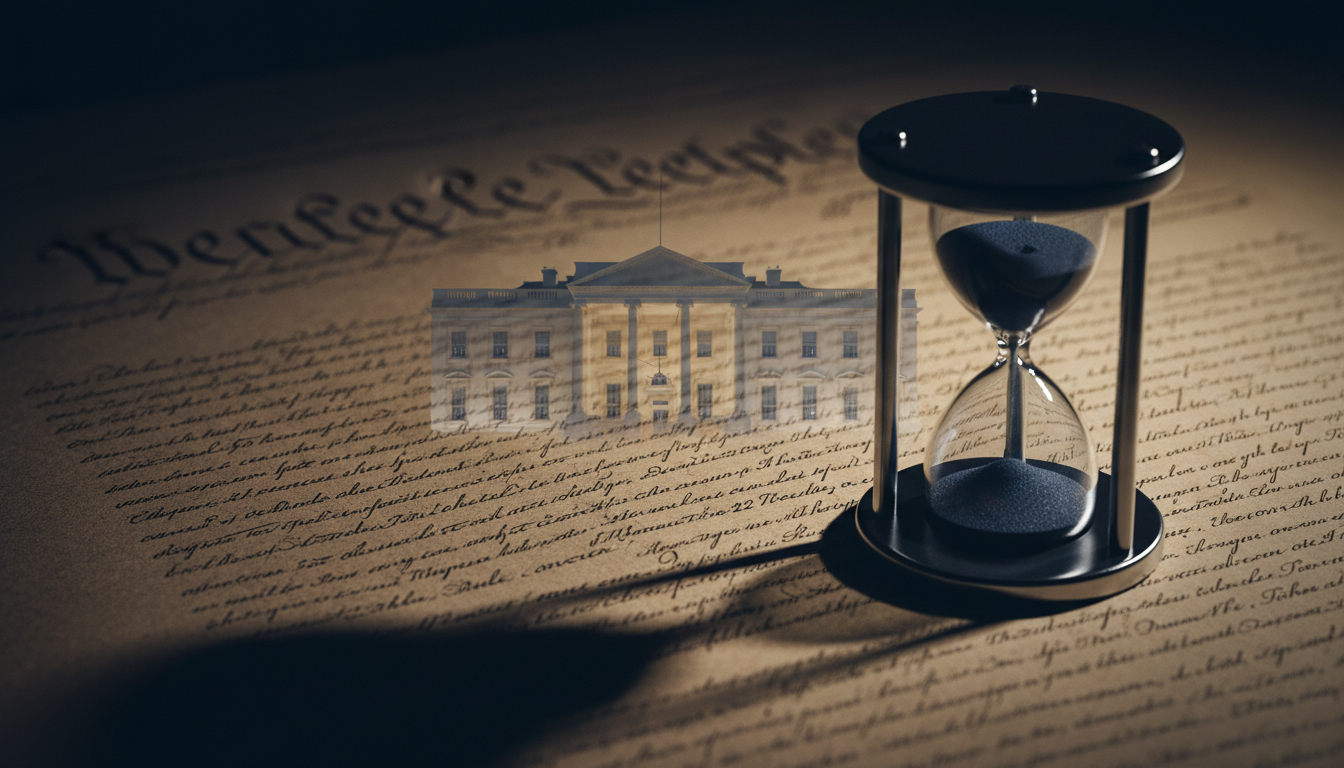Donald Trump’s presidency has once again taken center stage in American and global politics. As he embarks on what is constitutionally his final term, the question many observers quietly ask remains: Can Trump extend his presidency beyond this term? This question, while speculative, touches deep currents in American constitutional law, political culture, and the populist momentum that has defined Trump’s political brand since 2016.
But to understand whether Trump can legally extend his rule — or even would try — we must explore the intertwined factors shaping the latter part of his presidency: the laws governing presidential terms, his second‑term economic and political actions, public sentiment, and the broader implications for American democracy.
This article provides a detailed breakdown of:
- Trump’s second‑term policies and executive decisions in 2025.
- Their economic and political effects on the United States.
- What Americans currently think of his leadership.
- The strict constitutional rules that define — and limit — presidential power.
- Why, despite speculation, Trump cannot legally extend his presidency.
1. The Return of Trump: What His Second Term Looks Like
Trump’s comeback to the White House in 2025 reignited debates about nationalism, protectionism, and America’s global posture. Within the first year of his term, his administration issued more than 200 executive orders, marking one of the most aggressive policy pushes in modern U.S. history.
a. Economic Policy and Tariffs
Trump reinstated and expanded tariffs on Chinese and European goods. His campaign promise to “protect American workers” translated into a tough trade stance intended to bring manufacturing back home.
- Goal: Encourage domestic production and punish countries accused of unfair trade practices.
- Outcome: Mixed. Some industries, like steel and aluminum, saw modest job recovery. But other sectors — especially retail, automotive, and agriculture — faced higher costs.
- Result: Inflationary pressure rose, with consumer prices escalating due to import taxes that businesses passed on to consumers.
b. Immigration and Border Policies
Building on his hallmark “America First” agenda, Trump tightened border controls and reduced the number of visas for both skilled and unskilled labor.
- Impact: Certain industries reliant on immigrant labor, such as agriculture, hospitality, and construction, faced workforce shortages.
- Public reaction: Divided — his base applauded the moves as restoring “law and order,” while opponents warned of economic and humanitarian consequences.
c. Foreign Policy Realignment
Trump’s administration pivoted America’s foreign relationships toward pragmatic realism.
- Renewed tariffs and political pressure on China reshaped supply chain alliances.
- Greater distance from NATO partners reignited transatlantic tensions.
- Middle Eastern relations revived the “peace‑through‑strength” doctrine — with stronger support for Israel and renewed talks on Iran deterrence.
- Relations with Russia and North Korea remained controversial but consistent with Trump’s emphasis on “direct diplomacy.”
This transactional approach solidified Trump’s image as an unwavering negotiator but also increased uncertainty in global markets and diplomatic circles.
2. Economic and Political Impact: America Under Trump, Again
Trump’s second‑term policies triggered both revival and turbulence — depending on whom you ask.
a. Economic Growth and Inflation
Initially, fiscal stimulus and tariffs created a short‑term boost for domestic industries. Yet, by late 2025, economists began to note three key trends:
- Sustained inflation: Tariffs increased import and production costs.
- Interest rate pressure: The Federal Reserve maintained high rates to contain inflation, impacting housing and borrowing.
- Uneven growth: Manufacturing revived modestly in Rust Belt states, but consumer sectors weakened due to higher prices.
b. Employment and Wages
- Jobs: Unemployment remained relatively low (~4–4.5%), partly due to reduced immigration tightening the labor supply.
- Wages: Stagnant in real terms — nominal gains were eroded by inflation.
- Effect: The working and lower‑middle classes, once Trump’s core constituency, felt squeezed despite his populist rhetoric.
c. Political Polarization
Trump’s governance style — emphasizing executive orders over legislative consensus — deepened partisan divides.
- Republican support: Solid, with GOP leadership aligning closely with Trump’s platform.
- Democratic opposition: Fierce, emphasizing institutional balance and checks on power.
- Result: Polarization became structural. States increasingly diverged on tax, healthcare, and education models, fueling federalism debates about states’ rights versus executive dominance.
3. Public Opinion: What Americans Think of Trump’s Policies
By mid‑2025, public polling showed that Trump’s approval rating had begun to slip, particularly on economic management.
a. Polling Snapshot
Several nationwide polls revealed:
- Overall job approval: Averaging 38–42%.
- Economy: 60% of Americans expressed concern about inflation and rising costs.
- Tariffs: Nearly 70% believed tariffs increased their monthly expenses.
- Foreign policy: 50% viewed his positions as “too confrontational,” while 35% saw them as “necessary to protect U.S. interests.”
b. Adaptation and Behavior
Economically, Americans adapted by tightening household budgets:
- Reduced discretionary spending (travel, restaurants, luxury goods).
- Shifted to discount retailers and domestic alternatives when possible.
- Increased consumer debt to offset cost‑of‑living rises.
The middle class, long the focus of Trump’s economic promises, reported mixed feelings — appreciation for tax cuts and job security paired with frustration over persistent price hikes.
c. Public Sentiment and Political Narrative
Trump’s approval remained strongest among rural and industrial regions skeptical of globalism. Yet, in suburban America — especially among independents and moderate conservatives — fatigue with political uncertainty grew. Polls also suggested a rising appetite for institutional stability and more predictable economic planning.
4. The Constitutional Framework: Why Trump Cannot Legally Extend His Presidency
Now, to the central question: Can Donald Trump actually extend his presidency beyond his current term?
a. The 22nd Amendment: Two Terms, No More
The U.S. Constitution’s 22nd Amendment (ratified in 1951) clearly limits any individual to two elected terms as President.
Full text (paraphrased for clarity):
No person shall be elected to the office of the President more than twice.
No person who has served more than two years of another’s term may be elected more than once.
This makes the rule unambiguous: two terms is the absolute maximum, regardless of continuity or electoral gaps.
b. The 20th Amendment: Ending the Term
The 20th Amendment establishes that every presidential term ends at noon on January 20th following the election year. The clock cannot be paused, extended, or delayed — not even by Congress or executive action.
c. No Emergency Extensions
Unlike some parliamentary systems, the U.S. presidency cannot be “renewed” or extended under emergency declarations (war, terrorism, or pandemics). Even during the Civil War, both World Wars, and COVID‑19, elections and transfers of power occurred as scheduled.
d. What If Elections Were Disrupted?
If an election could not be completed for extraordinary reasons (a scenario considered extremely unlikely), the Constitution dictates succession:
- The presidency would temporarily pass to the Vice President or, failing that, to the Speaker of the House, under the Presidential Succession Act (1947).
That clause ensures continuity without extending the sitting president’s authority.
e. Changing the Rule: A Nearly Impossible Path
To alter the two‑term limit, the U.S. would need a constitutional amendment, requiring:
- Approval by two‑thirds of both the House and Senate.
- Ratification by three‑quarters (38) of U.S. states.
Given America’s current political polarization, such an amendment is functionally impossible.
5. Could Trump Even Consider Testing Those Limits?
Politically, Trump has always thrived on testing norms, so it’s not surprising that speculation arises about whether he might hint at extending his rule. However, the barriers are immense.
a. Political Reality Check
- Even strong allies in Congress would likely resist efforts seen as undermining the Constitution.
- The judiciary, particularly the Supreme Court, would inevitably block any attempt to overstay a lawful term.
- The U.S. military and civil service operate under strict constitutional loyalty to lawful civilian authority — not personality or party.
b. Historical Precedent
No U.S. president has ever successfully challenged this limit.
Franklin D. Roosevelt served four terms only because the limit didn’t exist at that time. After that experience, Congress and the states codified the two‑term rule precisely to prevent the concentration of executive power — a reaction many historians describe as a “safeguard against authoritarian drift.”
c. Trump’s Incentives
Although Trump’s political persona thrives on defiance, he remains aware that direct attempts to extend power would spark near‑total institutional resistance.
His focus, instead, appears to be consolidating influence within the Republican Party and shaping the judiciary and bureaucracy in ways that outlast his presidency — a more subtle and achievable legacy extension.
6. Legacy and Long‑Term Implications
Even though Trump cannot legally extend his presidency, his political legacy may well shape U.S. governance for years to come.
a. Redefinition of Populism
Trump’s populist brand — distrust of elites, skepticism of globalization, prioritization of national over international institutions — has become a structural force within American politics. It influences local elections, education debates, and foreign policy discourse.
b. Judiciary and Institutions
Through judicial appointments and regulatory changes, Trump has already rebalanced the federal judiciary toward conservative interpretations. That enduring shift affects rulings on abortion, immigration, gun rights, and executive power for decades.
c. The Global Message
Abroad, Trump’s presidency represents both a challenge and a lesson. His rise reaffirmed that populist movements can seize and maintain power in even the most established democracies — but also that institutional checks (like term limits) remain resilient.
7. Looking Ahead: What Happens After Trump’s Final Term?
With Trump constitutionally bound to leave office at the end of his current term, speculation now turns to his political heirs.
Possible successors
- Family members like Donald Trump Jr. or others in his inner circle could leverage the “Trump brand.”
- Loyalists and ideological allies may frame future campaigns as “continuations” of his vision.
- The GOP’s identity after Trump will depend on whether it reverts to traditional conservatism or continues along populist‑nationalist lines.
Regardless, Trump’s ability to dominate American political conversation — even after leaving office — ensures his influence will continue long after his presidency formally ends.
Conclusion
So, can Donald Trump extend his presidency?
No — at least not legally, constitutionally, or practically. The U.S. system was specifically designed to prevent that.
Yet, in a broader sense, Trump’s impact already extends beyond his presidency. His policies have reshaped America’s economic landscape, political divisions, and institutional debates about federal power. Whether admired as a disruptor or criticized as a divider, Trump’s legacy will persist long after his term expires — precisely because his political movement has tapped into enduring currents of American identity, skepticism, and resilience.
In the end, Trump may not rewrite the Constitution—but he has already rewritten the playbook of American politics.









